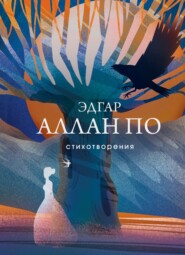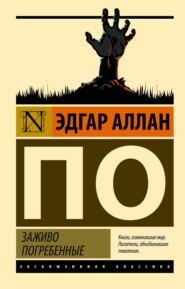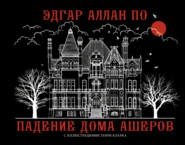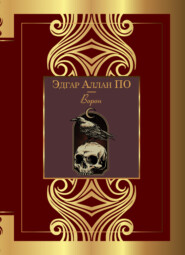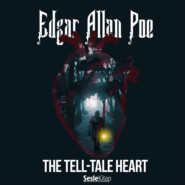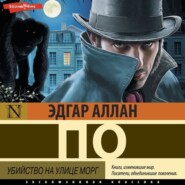По всем вопросам обращайтесь на: info@litportal.ru
(©) 2003-2025.
✖
Selections from Poe
Настройки чтения
Размер шрифта
Высота строк
Поля
THE SLEEPER (Page 11)
Published as "Irene" in 1831 and 1836, and as "The Sleeper" in 1843 and 1845. The theme is Poe's favorite, the death of a beautiful young woman, and the poem is remarkable, even among Poe's, for its melody.
LENORE (Page 13)
Published as "A Pæan" in 1831 and 1836, and as "Lenore" in 1843 and 1845. It was much altered in its numerous revisions.
1. broken is the golden bowl. See Ecclesiastes xii. 6.
2. Stygian river. The Styx was a river of Hades, across which the souls of the dead had to be ferried.
3. Guy De Vere: the mourning lover. It is he who speaks in the second and fourth stanzas.
13. Peccavimus: literally, "we have sinned." This stanza is the reply of the false friends.
THE VALLEY OF UNREST (Page 14)
Published in 1831 as "The Valley Nis," with an obscure allusion to a
"Syriac Tale":
Something about Satan's dart —
Something about angel wings —
Much about a broken heart —
All about unhappy things:
But "the Valley Nis" at best
Means "the Valley of Unrest."
Later it was published in magazines and in the 1845 edition, revised and improved, and transformed into a simple landscape picture, – one of the strange, weird, unearthly landscapes so characteristic of Poe.
THE COLISEUM (Page 15)
This poem was submitted in the prize contest in Baltimore in 1833, and would have been successful but for the fact that the author's story, "The Manuscript Found in a Bottle," had taken the first prize in its class. It was republished several times, but not much altered. The usual spelling is "Colosseum." It is very unlikely that Poe ever saw the Colosseum, though it is barely possible his foster parents may have taken him to Rome during the English residence (see Introduction, page xii).
13-14. Apparently a reference to Jesus, but characteristically vague.
15-16. The ancient Chaldeans were famous students of the heavens and practiced fortune telling by the stars; during the Middle Ages astrologers were commonly called "Chaldeans."
17. hero fell. Explain the allusion. Read an account of the Colosseum in a history or reference book.
18. mimic eagle: the eagle on the Roman standard.
20. gilded hair: adorned with golden ornaments.
26-29. arcades, plinths, shafts, entablatures, frieze, cornices. Consult the dictionary and explain these architectural terms.
36. Memnon: a gigantic statue of this Greek hero on the banks of the Nile was said to salute the rising sun with a musical note.
HYMN (Page 16)
Published in 1835 in the tale "Morella," and several times afterward in magazines and collections. As an expression of simple, religious trust and hope, this poem stands quite apart from all others by Poe.
TO ONE IN PARADISE (Page 17)
Published in 1835 as part of the tale called "The Visionary," afterward "The Assignation"; in 1839 in a magazine under the title "To Ianthe in Heaven"; and several times afterward in magazines and in collections. It fits admirably into the story "The Assignation," where it contains this additional stanza, readily understood in its setting:
Alas! for that accursed time
They bore thee o'er the billow,
From Love to titled age and crime
And an unholy pillow —
From me, and from our misty clime
Where weeps the silver willow.
TO F – (Page 18)
Appeared in 1835 under the title "To Mary," and in 1842 and 1843, "To One Departed." It is not known to whom these forms were addressed. In 1845 it again appeared with the above title, which is believed to refer to Mrs. Frances Sargent Osgood, a poet of the time, whom Poe greatly admired.
TO F – S S. O – D (Page 18)
First appeared in the Southern Literary Messenger(1835) as "Lines Written in an Album," addressed to Eliza White, a young daughter of the editor of the Messenger; in 1839 the same lines were addressed "To – ," whose name is unknown; and in 1845 they were addressed under the above title to Mrs. Osgood (see note on the preceding poem).
TO ZANTE (Page 18)
Published in 1837, 1843, and 1845. In form this is a regular Shakespearean sonnet. Zante is one of the principal Ionian islands, in ancient times called Zacynthus. Again the poet writes of a fair isle in the sea; point out other instances. Note the fondness for "no more," and find examples in other poems. As usual with Poe, the thread of thought is slight and indefinite; apparently the beautiful island has become "accursed ground" because of the death there of the "maiden that is no more."
1. fairest of all flowers. There is a zantewood, or satinwood, but it does not take its name from this island. Poe associated the name of the island with the hyacinth, but there is no etymological connection. He probably derived his fancy from a passage in Chateaubriand's "Itinéraire de Paris à Jérusalem," page 53.
13. hyacinthine isle: a reference to the flowers of the island (see preceding note).
14. "Isola d'oro! Fior di Levante!" "Golden Isle! Flower of the Levant!" These are Italian terms for Zante; they occur in the passage in Chateaubriand referred to in the note on line 1.
BRIDAL BALLAD (Page 19)
Published in 1837, 1841, 1845, and greatly improved in revision. The bride remembers her dead lover who died in battle, and wonders fearfully whether "the dead who is forsaken" knows and is unhappy.
SILENCE (Page 20)
Published in 1840, 1843, and 1845.
THE CONQUEROR WORM (Page 21)
Published in 1843 and 1845. The repulsive imagery recurs in several of the tales and poems, and shows one of the most morbid phases of Poe's imagination (see Introduction, page xxiv). It would hardly meet Poe's own test of beauty, but the grim power of this terrible picture is palpable enough.
9. Mimes: actors, who in this case are men; mankind.
13. vast formless things: doubtless the Fates (consult Gayley's "Classic Myths"); at any rate beings who exercise the same powers.
15. condor wings. The condor is a great vulture of South America; the word here suggests the Fates preying on human happiness, health, and life.
Published as "Irene" in 1831 and 1836, and as "The Sleeper" in 1843 and 1845. The theme is Poe's favorite, the death of a beautiful young woman, and the poem is remarkable, even among Poe's, for its melody.
LENORE (Page 13)
Published as "A Pæan" in 1831 and 1836, and as "Lenore" in 1843 and 1845. It was much altered in its numerous revisions.
1. broken is the golden bowl. See Ecclesiastes xii. 6.
2. Stygian river. The Styx was a river of Hades, across which the souls of the dead had to be ferried.
3. Guy De Vere: the mourning lover. It is he who speaks in the second and fourth stanzas.
13. Peccavimus: literally, "we have sinned." This stanza is the reply of the false friends.
THE VALLEY OF UNREST (Page 14)
Published in 1831 as "The Valley Nis," with an obscure allusion to a
"Syriac Tale":
Something about Satan's dart —
Something about angel wings —
Much about a broken heart —
All about unhappy things:
But "the Valley Nis" at best
Means "the Valley of Unrest."
Later it was published in magazines and in the 1845 edition, revised and improved, and transformed into a simple landscape picture, – one of the strange, weird, unearthly landscapes so characteristic of Poe.
THE COLISEUM (Page 15)
This poem was submitted in the prize contest in Baltimore in 1833, and would have been successful but for the fact that the author's story, "The Manuscript Found in a Bottle," had taken the first prize in its class. It was republished several times, but not much altered. The usual spelling is "Colosseum." It is very unlikely that Poe ever saw the Colosseum, though it is barely possible his foster parents may have taken him to Rome during the English residence (see Introduction, page xii).
13-14. Apparently a reference to Jesus, but characteristically vague.
15-16. The ancient Chaldeans were famous students of the heavens and practiced fortune telling by the stars; during the Middle Ages astrologers were commonly called "Chaldeans."
17. hero fell. Explain the allusion. Read an account of the Colosseum in a history or reference book.
18. mimic eagle: the eagle on the Roman standard.
20. gilded hair: adorned with golden ornaments.
26-29. arcades, plinths, shafts, entablatures, frieze, cornices. Consult the dictionary and explain these architectural terms.
36. Memnon: a gigantic statue of this Greek hero on the banks of the Nile was said to salute the rising sun with a musical note.
HYMN (Page 16)
Published in 1835 in the tale "Morella," and several times afterward in magazines and collections. As an expression of simple, religious trust and hope, this poem stands quite apart from all others by Poe.
TO ONE IN PARADISE (Page 17)
Published in 1835 as part of the tale called "The Visionary," afterward "The Assignation"; in 1839 in a magazine under the title "To Ianthe in Heaven"; and several times afterward in magazines and in collections. It fits admirably into the story "The Assignation," where it contains this additional stanza, readily understood in its setting:
Alas! for that accursed time
They bore thee o'er the billow,
From Love to titled age and crime
And an unholy pillow —
From me, and from our misty clime
Where weeps the silver willow.
TO F – (Page 18)
Appeared in 1835 under the title "To Mary," and in 1842 and 1843, "To One Departed." It is not known to whom these forms were addressed. In 1845 it again appeared with the above title, which is believed to refer to Mrs. Frances Sargent Osgood, a poet of the time, whom Poe greatly admired.
TO F – S S. O – D (Page 18)
First appeared in the Southern Literary Messenger(1835) as "Lines Written in an Album," addressed to Eliza White, a young daughter of the editor of the Messenger; in 1839 the same lines were addressed "To – ," whose name is unknown; and in 1845 they were addressed under the above title to Mrs. Osgood (see note on the preceding poem).
TO ZANTE (Page 18)
Published in 1837, 1843, and 1845. In form this is a regular Shakespearean sonnet. Zante is one of the principal Ionian islands, in ancient times called Zacynthus. Again the poet writes of a fair isle in the sea; point out other instances. Note the fondness for "no more," and find examples in other poems. As usual with Poe, the thread of thought is slight and indefinite; apparently the beautiful island has become "accursed ground" because of the death there of the "maiden that is no more."
1. fairest of all flowers. There is a zantewood, or satinwood, but it does not take its name from this island. Poe associated the name of the island with the hyacinth, but there is no etymological connection. He probably derived his fancy from a passage in Chateaubriand's "Itinéraire de Paris à Jérusalem," page 53.
13. hyacinthine isle: a reference to the flowers of the island (see preceding note).
14. "Isola d'oro! Fior di Levante!" "Golden Isle! Flower of the Levant!" These are Italian terms for Zante; they occur in the passage in Chateaubriand referred to in the note on line 1.
BRIDAL BALLAD (Page 19)
Published in 1837, 1841, 1845, and greatly improved in revision. The bride remembers her dead lover who died in battle, and wonders fearfully whether "the dead who is forsaken" knows and is unhappy.
SILENCE (Page 20)
Published in 1840, 1843, and 1845.
THE CONQUEROR WORM (Page 21)
Published in 1843 and 1845. The repulsive imagery recurs in several of the tales and poems, and shows one of the most morbid phases of Poe's imagination (see Introduction, page xxiv). It would hardly meet Poe's own test of beauty, but the grim power of this terrible picture is palpable enough.
9. Mimes: actors, who in this case are men; mankind.
13. vast formless things: doubtless the Fates (consult Gayley's "Classic Myths"); at any rate beings who exercise the same powers.
15. condor wings. The condor is a great vulture of South America; the word here suggests the Fates preying on human happiness, health, and life.








